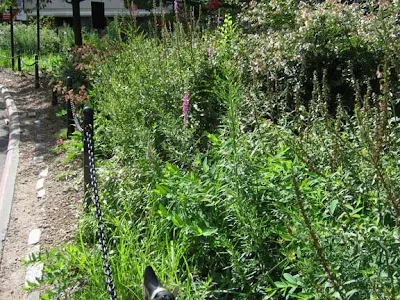Much Strife at City Hall!

How 'bout this patch?
What is disturbing about the City Hall Park loosestrife is that they're either willfully planted by professionals or not recognized by professionals. City Hall Park was renovated and re-planted in 1999. And this is odd, NYC Parks website lists it as a blooming plant of July in Manhattan, leaving it out of the other boroughs. Is there a dedicated loosestrife constituency in Manhattan that demands its August purple?
This morning I was thinking that I do not see purple loosestrife much in private gardens; maybe only three times in the last 5 years. As I thought this I walked passed a lovely garden in Ditmas Park where those magenta spikes gave another plant away. Loosestrife looks wonderful in just the kind of casual garden beds that I admire, and it does so in August, when all else seems to be failing. As I've said before, and I think this to be the case for many gardeners, Purple Loosestrife doesn't seem to elicit a gardener's rage. Probably because its an invasive of wild lands, not a weed of gardens. We look at it and at worst say it's too bad we can't plant one.
Its easy for us to deduce that most new wetland invasions will be spread via the wild plants, not those from our garden. Lord knows there's millions of them out there already, having spread all by themselves. I was in the Mohawk Valley last week and saw entire wetlands dense with magenta-purple -an amazing sight. It's also easy to say the noose is already around our necks, may as well be hanged.
This morning I was thinking that I do not see purple loosestrife much in private gardens; maybe only three times in the last 5 years. As I thought this I walked passed a lovely garden in Ditmas Park where those magenta spikes gave another plant away. Loosestrife looks wonderful in just the kind of casual garden beds that I admire, and it does so in August, when all else seems to be failing. As I've said before, and I think this to be the case for many gardeners, Purple Loosestrife doesn't seem to elicit a gardener's rage. Probably because its an invasive of wild lands, not a weed of gardens. We look at it and at worst say it's too bad we can't plant one.
Its easy for us to deduce that most new wetland invasions will be spread via the wild plants, not those from our garden. Lord knows there's millions of them out there already, having spread all by themselves. I was in the Mohawk Valley last week and saw entire wetlands dense with magenta-purple -an amazing sight. It's also easy to say the noose is already around our necks, may as well be hanged.
I don't get much opportunity to get close to wetland loosestrife, usually seen racing by in a car. But the City Hall Park plantings allowed me total access for these ID pictures. As always, click on the photo for a larger image.

The brown seed capsules after flowers are spent. The wetlands aren't as pretty after the magenta is gone.









thanks for the thorough i.d. photos. very clear.
ReplyDeleteThankyou for your answer, via Marie. After reading your note to me I came here and-wow! It's a shame so many "pretty" things get out of control then have to be declared.I think if we got rid of all the nasties from Australia we'd be pretty barren!For some time now I've tried to convince people to grow a look-alike. In the case of lossestrife I'd be looking at a Salvia.I adore lilac, but here? My best shot is Lagerstroemea.
ReplyDeleteI'm bookmarking this blog. Thanks.
I love Crape Myrtle, although more of a small tree than a garden perennial.
ReplyDeleteThe first time I saw it was in Louisiana and so I was surprised to see it growing in Brooklyn years back. Now I see we're a warm city.
I grow salvias too, so many kinds!
This link gives you alternatives in New England, but I think for PL, it falls short. You type in plant, it gives alternatives:
http://efg.cs.umb.edu/nativeplants/
Thanks for reading!
Thanks to your great photos, I see that you are indeed looking at Purple Loosestrife. I recently had a close call with a false ID and almost pulled out something innocuous. I blog about what I am learning and doing on my 44 acres in Wisconsin, check out my post on Purple Loosestrife to see it's look-alike. http://digginginthedriftless.wordpress.com/2009/07/21/purple-loosestrife-a-very-short-battle/
ReplyDeleteI drive through Western Wisconsin every year on my way to my father in laws place in western Hennepin County, Mn. So far, no loosestrife there, but the environment is ripe for it, with all those old lakes.
ReplyDeleteI like Western Wisc, very pretty- and in some places, despite the hills, reminds me of my native Long Island, NY. Oaks, sand, pine, cedar.